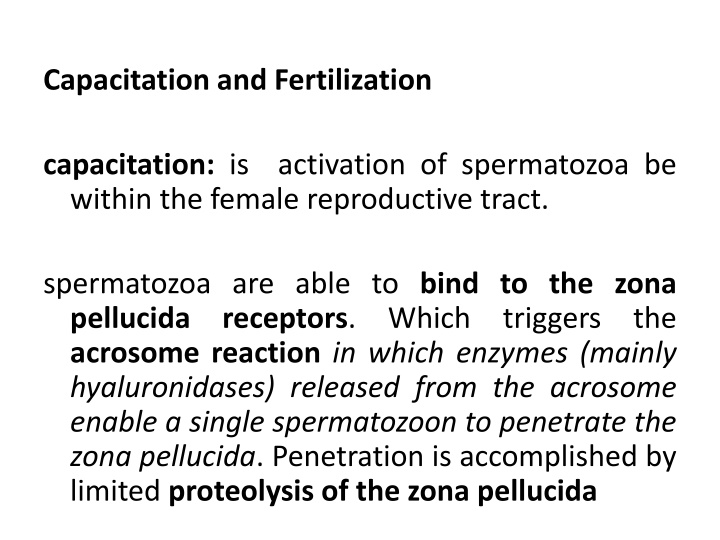
Fertilization Process in Reproduction
Discover the intricate steps of fertilization, from sperm capacitation to embryonic cleavage. Learn why only one sperm completes fertilization and how yolk influences egg types. Explore the key reactions that prevent polyspermy and initiate zygote development in this comprehensive guide.
Download Presentation

Please find below an Image/Link to download the presentation.
The content on the website is provided AS IS for your information and personal use only. It may not be sold, licensed, or shared on other websites without obtaining consent from the author. If you encounter any issues during the download, it is possible that the publisher has removed the file from their server.
You are allowed to download the files provided on this website for personal or commercial use, subject to the condition that they are used lawfully. All files are the property of their respective owners.
The content on the website is provided AS IS for your information and personal use only. It may not be sold, licensed, or shared on other websites without obtaining consent from the author.
E N D
Presentation Transcript
Capacitation and Fertilization capacitation: is activation of spermatozoa be within the female reproductive tract. spermatozoa are able to bind to the zona pellucida receptors. acrosome reaction in which enzymes (mainly hyaluronidases) released from the acrosome enable a single spermatozoon to penetrate the zona pellucida. Penetration is accomplished by limited proteolysis of the zona pellucida Which triggers the
After spermatozoon enters the perivitelline space between the zona pellucida and the oocyte plasma membrane (or oolemma). the spermatozoon plasma membrane fuses with the oolemma, and the nucleus of the sperm head is finally incorporated into the oocyte. This process, called the impregnation of the oocyte, allows the nucleus of the sperm After the alignment and membranes of the two pronuclei, the resulting zygote, with its diploid (2n) complement of 46 chromosomes, undergoes a mitotic division or first cleavage. penetrating the zona pellucida, the dissolution of nuclear
Why only one spermatozoon completes the fertilization process? As the fertilizing spermatozoon penetrates the ooplasm, at least three types of postfusion reactions occur to prevent other spermatozoa from entering the secondary oocyte (polyspermy). These events include the following. Fast block to polyspermy. A large and long-lasting (up to 1 minute) depolarization of the oolemma creates a transient electrical block to polyspermy. Cortical reaction. Changes in the polarity of the oolemma then trigger release of Ca2_ from the ooplasmic stores. The Ca2_ propagates a cortical reaction wave in which cortical granules move to the surface and fuse with the oolemma, leading to a transient increase in surface area of the ovum and reorganization of the membrane. The contents of the cortical granules are released into the perivitelline space. Zona reaction. The released enzymes (proteases) of the cortical granules not only degrade the glycoprotein oocyte plasma membrane receptors for sperm binding but also form the perivitelline barrier by cross-linking proteins on the surface of the zona pellucida. This event creates the final and permanent block to polyspermy.
Embryonic cleavage: Shortly after fertilization, the zygote undergoes a series of rapid mitotic devision. This process of dividing the zygote into many cells is called embryonic cleavage.
Influence of yolk: Eggs can be classified into four main types based on their yolk contents: Isolecithal eggs, as found in sea stars and human, which have relativley little yolk and in which the yolk is uniformly distrbuted throughout the egg. Mesolecithal eggs, as found in frogs, toads, and salamander, which have a moderate amount of yolk, and which have a concentration of yolk in the vegetal (lower) hemisohere. Telolecithal eggs, as found in birds, and reptiles, which have a large amount of yolk, and the cleavage portion of the embryo is restricted to a small disc at one end of the egg. Centrolecithal eggs, as found in insects, which have much yolk and in which the actively developing pattern of the embryo forms a thin layer around the outside of the large central yolk mass.
Pattern of cleavage: The cleavage of an embryo can be complete or incomplete, depending on the relative amount of yolk contained in the egg. Complete cleavage happen in isolecithal eggs and meso lecithal eggs and also called holoblastic cleavage because the whole embryo embryo divided into cells. Incomplete cleavage detected in telolecithal eggs and centrolecithal eggs. They do not divided completely into cells because of the thick, visccous nature of the yolk mass. In such eggs, cleavage is limited to some portion on the surface of the embryo with a large underlying yolk that provides nutrients and energy for the developing embryo.
Spiral cleavage: Many flat molluscs exhibit spiral cleavage. The first two cleavage planes are vertical and produce blastomeres of equal size. The third cleavage is horizental and produces four blasomeres of unequal size, four smaller micromeres nearest the animal pole on the upper surface, and four larger macromeres nearest the vegetal pole on the lower surface of the egg. worms, nematodes, and most
Radial cleavage: Sea star, sea urchin, and frogs exhibit radial cleavage. In this type of cleavage, the first two cleavage planes are vertical and produce blastomeres of equal size. The third plane is horizental and produces micromeres and four large macromeres. four small
Rotentional cleavage: Mammales like human also have holoblastic cleavage, but their rotational. After second cleavage, one pair of blastomeres comes to lie at right angle to others. cleavage pattern is Bilateral cleavage: Pattern in which the first cleavage plane divides the embryo into right and left halves.
Discoidal cleavage: Found in telolecithal eggs, only part of the embryo is divided, and much of the yolky part of the embryo remains undivided. Superficial cleavage: Is found in arthropods in which yolk is concentrated in the center of the egg and the cleavage restricted to the outer surface.
Implantation: The cell mass resulting from the series of mitotic divisions is known as a morula, and the individual cells are known as blastomeres. During the third day after fertilization, the morula, which has reached a 12- to 16- cell stage and is still surrounded by the zona pellucida, enters the uterine cavity. The morula remains free in the uterus for about a day while continued cell division and development occur. The early embryo gives rise to a blastocyst, a hollow sphere of cells with a centrally located clump of cells. 1. inner cell mass will give rise to the tissues of the embryo proper. 2. outer cell mass, will form the trophoblast and then the placenta. Fluid passes inward through the zona pellucida during this process, forming a fluid-filled cavity, the blastocyst cavity. This event defines the beginning of the blastocyst. As the blastocyst remains free in the uterine lumen for 1 or 2 days and undergoes further mitotic divisions, the zona pellucida disappears. The outer cell mass is now called the trophoblast, and the inner cell mass is referred to as the embryoblast.
The attachment of the blastocyst to the endometrial epithelium occurs during the implantation window, the period when the uterus is receptive for implantation of the blastocyst. In the human, the implantation window begins on day 6 after the LH surge and is completed by day 10.
The invading trophoblast differentiates into the syncytiotrophoblast and the cytotrophoblast. The cytotrophoblast is a mitotically active inner cell layer producing cells that fuse with the syncytiotrophoblast, the outer erosive layer. The syncytiotrophoblast is not mitotically active and consists of a multinucleate cytoplasmic mass; it actively invades the epithelium and underlying stroma of the endometrium. Through the activity of the trophoblast, the blastocyst is entirely embedded within the endometrium on about the 11th day of development.
Decidualization of endometrium: During pregnancy, endometrium that undergoes morphologic changes is called the decidua or decidua graviditas. the portion of the The decidua includes all but the deepest layer of the endometrium. differentiate into large, rounded decidual cells. The stromal cells
Three different regions of the decidua are identified by their relationship to the site of implantation: The decidua basalis is the portion of the endometrium that underlies the implantation site. The decidua capsularis is a thin portion of endometrium that implantation site and the uterine lumen. The decidua parietalis includes the remaining endometrium of the uterus. lies between the
By the 13th day of development, an extraembryonic space, the chorionic cavity, has been established. The cell layers that form the outer boundary of this cavity (i.e., the cytotrophoblast, and extraembryonic somatic mesoderm) are collectively referred to as the chorion. The innermost membranes enveloping the embryo are called the amnion. syncytiotrophoblast,
Placenta: The placenta consists of a fetal portion, formed by the chorion, and a maternal portion, formed by the deciduas basalis. The two parts are involved in physiologic exchange of substances between the maternal and fetal circulations. The uteroplacental circulatory system begins to develop around day 9, with development of vascular trophoblastic lacunae syncytiotrophoblast. spaces within called the
The gestation period: The time retention of mammalian embryos in the uterus until fully developed young individuals are born; consist of: 1. Germinal period: this begins at fertilization and extends till the third week; up to formation of trilaminar germ disc. 2. Embryonic period: this extends from fourth to eighth week, involving changes in shape and external appearance of the cylindrical embryo, tissue and organogenesis. 3. Foetal period: this extends from third month upto termination of pregnancy, during which, there is a rapid growth of foetus and complete development of placenta.





